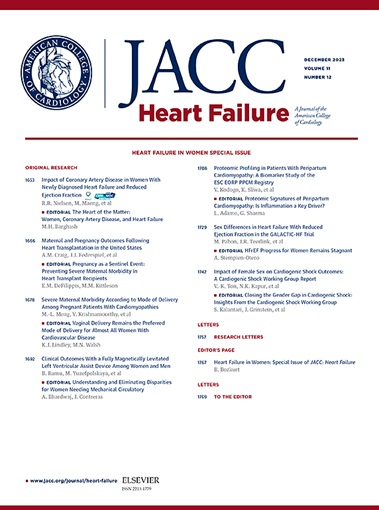Prospective Validation and Implementation Pilot Study of an Emergency Department Heart Failure Risk Stratification Tool
IF 10.3
1区 医学
Q1 CARDIAC & CARDIOVASCULAR SYSTEMS
引用次数: 0
Abstract
Background
The STRIDE-HF (Systematic Tool for Risk Identification and Decision-making in Emergency Heart Failure) emergency department (ED) risk tool was previously found to accurately predict the risk of a 30-day serious adverse event (SAE), including 30-day mortality, cardiopulmonary resuscitation, intra-aortic balloon pump insertion, intubation, new dialysis, myocardial infarction, or coronary revascularization.
Objectives
The aim of this study was to prospectively validate STRIDE-HF across 21 community EDs among patients in the ED with acute heart failure (AHF) from January 1, 2023, to December 31, 2023, and to assess the safety of the real-time use of risk estimates in a 2-ED pilot study.
Methods
Model area under the receiver operator curve (AUROC) and area under the precision recall curve (AUPRC), sensitivity, specificity, and positive and negative predictive values and likelihood ratios at key clinical thresholds are reported. In the clinical pilot, the rates of 30-day SAEs among patients who were at lower risk by STRIDE-HF and were discharged after ED or observation care were reported.
Results
There were 13,274 patients in the ED in the prospective validation; the median age was 76 years, 50.8% were female, and 44.5% were non-White; and 11.4%, 24.8%, 31.9%, and 31.9% of patients were at very low, low, moderate, and high risk, respectively. The 30-day SAE rates among very–low-risk and low-risk patients were 3.4% and 6.7%, respectively, and the 30-day mortality rates were <1% and <2%, respectively. STRIDE-HF was highly sensitive among low-risk patients (97.6%; 95% CI: 96.8%-98.2%); AUROC was 0.75 (95% CI: 0.74-0.76), and AUPRC was 0.43 (95% CI: 0.39-0.44). There were 845 patients in the pilot study; among patients classified by STRIDE-HF criteria as being at very low risk who were discharged, none experienced a 30-day SAE.
Conclusions
STRIDE-HF maintained high predictive accuracy for 30-day SAE in prospective validation in this large, diverse, multicenter cohort; the use of risk estimates in real time safely identified low-risk patients appropriate for discharge.
急诊科心力衰竭风险分层工具STRIDE-HF的前瞻性验证和实施试点研究。
背景:以前发现急诊科(ED)风险工具STRIDE-HF(紧急心力衰竭风险识别和决策系统工具)可以准确预测30天严重不良事件(SAE)的风险,包括30天死亡率、心肺复苏、主动脉内球囊泵插入、插管、新透析、心肌梗死或冠状动脉血运重建术。目的:本研究的目的是在2023年1月1日至2023年12月31日期间,在21个社区急诊科急性心力衰竭(AHF)患者中前瞻性验证STRIDE-HF,并在一项2-ED试点研究中评估实时使用风险评估的安全性。方法:报告模型接收算子曲线下面积(AUROC)和精确召回曲线下面积(AUPRC)、敏感性、特异性、阳性预测值和阴性预测值及关键临床阈值的似然比。在临床试验中,报告了在接受STRIDE-HF治疗风险较低且在ED或观察护理后出院的患者中发生30天SAEs的比率。结果:前瞻性验证共有13274例急诊科患者;中位年龄76岁,女性50.8%,非白人44.5%;11.4%、24.8%、31.9%和31.9%的患者分别为极低、低、中、高风险。极低风险和低风险患者的30天SAE发生率分别为3.4%和6.7%,30天死亡率为:结论:在这个大型、多样化、多中心队列的前瞻性验证中,STRIDE-HF对30天SAE保持了很高的预测准确性;使用风险评估实时安全地识别适合出院的低风险患者。
本文章由计算机程序翻译,如有差异,请以英文原文为准。
求助全文
约1分钟内获得全文
求助全文
来源期刊

JACC. Heart failure
CARDIAC & CARDIOVASCULAR SYSTEMS-
CiteScore
21.20
自引率
2.30%
发文量
164
期刊介绍:
JACC: Heart Failure publishes crucial findings on the pathophysiology, diagnosis, treatment, and care of heart failure patients. The goal is to enhance understanding through timely scientific communication on disease, clinical trials, outcomes, and therapeutic advances. The Journal fosters interdisciplinary connections with neuroscience, pulmonary medicine, nephrology, electrophysiology, and surgery related to heart failure. It also covers articles on pharmacogenetics, biomarkers, and metabolomics.
 求助内容:
求助内容: 应助结果提醒方式:
应助结果提醒方式:


